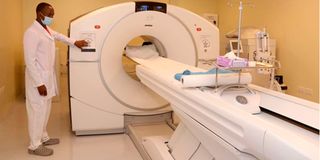New facility to boost cancer diagnosis in the country

Nuclear medicine technologist Samuel Kubania demonstrates the operation of a cyclotron machine at the Integrated Molecular Imaging Centre at the KUTRRH on January 10, 2022.
What you need to know:
- With the acquisition of a cyclotron machine, it is now possible to detect cancer in its early stages and save lives.
- Kenyatta University Teaching, Referral and Research Hospital is the first public hospital in East and central Africa to offer such services.
Kenyans can now get early cancer diagnosis and treatment from a public hospital as the Integrated and Molecular Imaging Centre on Monday diagnosed its first 10 patients.
The facility at the Kenyatta University Teaching, Referral and Research Hospital (KUTRRH) is one of a kind in the sub-Saharan region and a relief for patients who have had to travel abroad for cancer treatment.
With the acquisition of a cyclotron machine and an ultra-modern positron emission tomography-computed tomography (PET-CT) scan by the government last year, it is now possible to detect cancer in its early stages and save lives.
A cyclotron is a machine that produces radioactive isotopes that are used for imaging procedures with the aim of getting finer pictures of areas inside the human body.
A PET-CT scan, on the other hand, has a wide range of use in early diagnosis of cancer, heart diseases and brain disorders. In the case of cancer, the PET-CT scan can show how far the cancer has spread.
KUTRRH is the first public hospital in East and central Africa to offer such services.
The hospital’s board chair, Prof Olive Mugenda, yesterday told journalists that the hospital has the capacity to conduct cancer diagnosis for 50 patients a day.
Cancer diagnosis
“We have two PET-CT scan machines and we have decided to have two shifts where each machine will scan about 24 patients in a day,” she said.
Prof Mugenda said the centre will help the government in cutting medical trips for cancer diagnosis out of the country and instead, encourage medical tourism by having nationals of other African countries who need such services get them at KUTRRH.
“Kenyans don’t have to wait until they are feeling pain to get a cancer diagnosis. In consultation with their doctors, they should come for early detection, eventually saving more lives,” Prof Mugenda explained.
KUTRRH’s acting chief executive Dr Victor Njom said: “With the new scan (PET-CT), we are now able to look at the body at a microscopic level and find out how the body cells are working. This is in contrast with other types like an X-ray that just takes an image of the body. In that way, we are able to pick up abnormal cells very early,” he explains.
The hospital, together with the National Hospital Insurance Funds (NHIF) have approved a standardised fee for Kenyans of about Sh40,000 for registered members.
“Being a public facility, we will take care of the economic aspects and we hope that the pricing structure of our facility will be within insurance range,” said Dr Njom.
Cancer treatment
Kenyans who will pay cash will be charged about Sh55,000 and those who have subscribed to other insurance providers will be charged about 60, 000.
Nuclear medicine consultant Dr Harish Nagaraj, who works with at KUTRRH, yesterday told the Nation that the PET-CT scan will be used on referral basis.
“In our case, we do not routinely do PET-CT scans, it is done for patients who are supposed to have got specific information or clarification from earlier scans,” he said.
“Once we get referrals from an oncologist (a doctor who specialises in cancer treatment), we inject the patient with a radioactive sugar tracer called a fluorodeoxyglucose (FDG), which gets concentrated in the cancerous cells in the body. Depending on the area affected, then the doctors decide where the treatment should be given,” he explained.
He added that the scan takes about 25 minutes, but, before then, the patient is injected with FDG and given about an hour to make sure that it spreads in the target area.
“This is a big boost in the management of cancer because, before, we could know that there is some kind of lesion in the body but we couldn’t tell whether it is growing or not. This new technology will help us know the metabolic activity of a particular tumour and its exact location,” he explained.
He added: “If you look at the radiation aspect of the scan, it is quite negligible compared to the benefits that it will give to the patient’s healthcare and management.”





